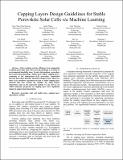Capping Layers Design Guidelines for Stable Perovskite Solar Cells via Machine Learning
Author(s)
Hartono, Noor Titan Putri; Thapa, Janak; Tiihonen, Armi; Oviedo, Felipe; Batali, Clio; Yoo, Jason Jungwan; Liu, Zhe; Li, Ruipeng; Marron, David Fuertes; Bawendi, Moungi G; Buonassisi, Anthony; Sun, Shijing; ... Show more Show less
DownloadAccepted version (257.3Kb)
Open Access Policy
Open Access Policy
Creative Commons Attribution-Noncommercial-Share Alike
Terms of use
Metadata
Show full item recordAbstract
© 2020 IEEE. After reaching a device efficiency level comparable to silicon, perovskite solar cell's next big challenge is to tackle its environmental instability issue. To solve this problem, researchers have started incorporating a buffer layer called 'capping layer', consisting of low dimensional (LD) perovskite, sandwiched between perovskite absorber and hole transport layer. However, there is no conclusive agreement on how to select capping layer material that best extends the stability. By using feature importance rank on the regression models, we can start to see which molecular properties on capping layer have significant impact in suppressing degradation.
Date issued
2020Department
Massachusetts Institute of Technology. Computer Science and Artificial Intelligence Laboratory; Massachusetts Institute of Technology. Department of Electrical Engineering and Computer Science; Massachusetts Institute of Technology. Department of Mechanical EngineeringJournal
Conference Record of the IEEE Photovoltaic Specialists Conference
Publisher
Institute of Electrical and Electronics Engineers (IEEE)
Citation
Hartono, Noor Titan Putri, Thapa, Janak, Tiihonen, Armi, Oviedo, Felipe, Batali, Clio et al. 2020. "Capping Layers Design Guidelines for Stable Perovskite Solar Cells via Machine Learning." Conference Record of the IEEE Photovoltaic Specialists Conference, 2020-June.
Version: Author's final manuscript